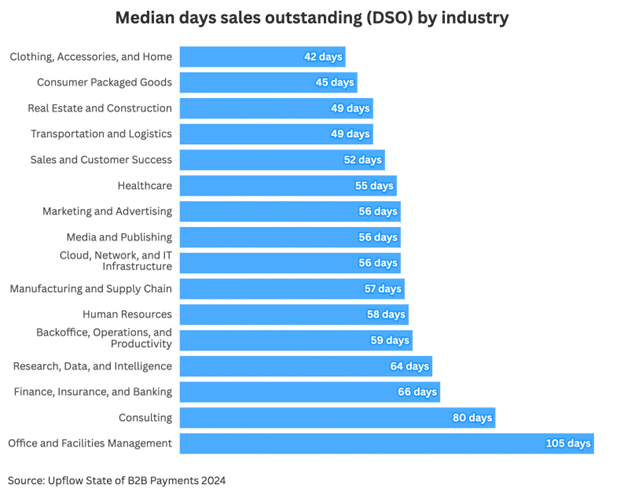When many businesses see winter on the horizon, they come to a similar conclusion: Cash flows will likely tighten. As customers make larger payments due to elevated holiday spending, invoices have a funny habit of trickling into the new year. This leaves suppliers waiting longer to get paid. Days sales outstanding (DSO) is a key metric that measures the time it takes a company to collect cash for credit purchases, and every winter there’s an inevitable slowdown trend.
Gateway Commercial Finance, an invoice factoring company, put together information on this winter slowdown by pulling data from leading sources like Small Fed Business, APQC, Resolve, and more. With this, you’ll be able to examine the fascinating correlation between the cooler months and cash flow freeze.
The winter payment effect explained
Believe it or not, the ‘winter payment effect’ isn’t something of myth. There is a very real seasonal lag in invoice payments that companies see during the holidays and first part of the year. The 2024 Report on Payments in Small Business Credit, conducted by the Federal Reserve, polled just over 6,000 small businesses and found that over 40% of small firms faced slower payments in the fourth quarter of the year.
Even larger corporations may make the strategic choice to stretch their payments windows to preserve end-of-year cash.
Industry payment performance rankings
While no industry is necessarily immune, the extent to which the winter payment effect is felt seems to vary by industry. Based on the Upflow State of B2B Payments 2024 study, which analyzed DSO across 500 organizations in varying industries, high-value sectors like security, identity, and compliance see the largest increase in wait times on average. Office and facilities management, however, sees the largest standalone median industry increase.
Sixteen other industries were stack-ranked in this report based on median day sales outstanding:
Just because an industry in particular sees an increase in DSO doesn’t necessarily mean every business within will feel the effects. Given this winter payment slowdown is caused by customers, your business effects may be mitigated if you have fast-paying clients.
Why winter hits different: Root cause analysis
With the ‘what’ of the winter payment slowdown outlined, let’s examine the ‘why.’ There are two main drivers behind the issue:
- Holiday-specific payment challenges
The holiday season interrupts a normal accounting cycle in a myriad of ways. Whether it’s a greater number of employees taking vacation, teams choosing to close books early to get ahead, or just general postponement, vendor payments typically are put on the back burner.
- The compounding effect
The above issue is only the tip of the iceberg for businesses expecting payment, though, as delays typically cascade once they begin. For perspective, if a manufacturer receives a late payment then it can also delay payouts to suppliers, service providers, contractors, or anyone else in the network.
Payment reality for SMBs
For small and midsize businesses, this winter slowdown can be devastating. Every additional day added to a company’s DSO can tie up cash that would otherwise be used for expenses. For smaller businesses, this holdup can hurt their ability to make important transactions, such as payroll, supply purchases, or quick reactions to market changes.
Without strong forecasting on when payments will be received, certain long-term projects may need to be delayed, leading to additional problems later down the pipeline.
Actionable solutions: Beat the winter slowdown
The best defense against the winter slowdown will be proper preparation. There are five main factors affecting DSO in businesses, and to blunt the issue you will need to implement strategies which touch all points. If your business is within a high-risk industry, consider some of the following tips.
- Set an earlier invoice timeline: As soon as milestones for tasks are met, consider sending an invoice; earlier submission can ensure it hits accounts payable systems before they go offline for the holiday.
- Implement progress billing: If you are working with a customer on a long project, consider temporary progress billing for the milestones around the holiday to at least reduce the amount outstanding.
- Offer early pay discounts: Even small incentives of 1%-2% off for payments that are made ahead of the scheduled net terms could result in an uptick of payments.
- Optimize your available payment methods: If your business primarily collects checks but has the ability to collect digitally, consider encouraging ACH or card during the holidays as it can be integrated with accounts receivables tools more quickly.
Bolster communication with customers: Offering a friendly reminder to your clients about their payment due dates ahead of the holiday can prevent delays at the start of the year.
Technology solutions to consider
By leveraging modern technology, your small-to-medium-sized business can further capitalize on the above tips. Consider automating all of your payment collections to reduce any manual follow-ups that may otherwise be required. Gathering these payments through portals that operate 24/7 will also streamline collection by increasing the periods of time during which payment can be sent.
Your organization should also be investing in ERP systems that allow for advanced cash flow financial modeling to forecast for the seasonal dips, so that you can manage your cash flows more effectively in the weeks leading up to the freeze.
Keep your business liquid in a frozen environment
Whether your organization is ready or not, the winter freeze can impact you any year. Just because it’s inevitable industry-wide doesn’t mean it needs to affect your business as strongly. By studying your historical DSO benchmarks, identifying whether your organization is at-risk, and taking proactive measures, you can maintain strong cash flows during the winter months.
This story was produced by Gateway Commercial Finance and reviewed and distributed by Stacker.

